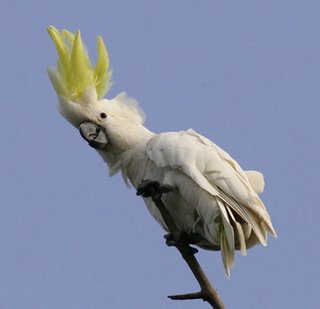Tanimbar Corella and Yellow-crested Cockatoo
 If you are at Changi Village and hear loud screeching, look around you, especially at the many tall angsana (Pterocarpus indicus) trees along the road. These are the Tanimbar Corella (Cacatua goffini) (above), also known as Tanimbar Cockatoo. There are usually about five birds around these trees and they are hole nesters.
If you are at Changi Village and hear loud screeching, look around you, especially at the many tall angsana (Pterocarpus indicus) trees along the road. These are the Tanimbar Corella (Cacatua goffini) (above), also known as Tanimbar Cockatoo. There are usually about five birds around these trees and they are hole nesters.There are up to 20 such corellas in the Loyang/Changi area. They are also found elsewhere in Singapore, including about 40 on Sentosa.
The other parrot commonly using these trees are the Red-breasted Parakeet (Psittacula alexandri), also known as the Moustached Parakeet. There are also about three Yellow-crested Cockatoos (Cacatua sulphurea) (below) around Changi but they hardly visit the village.
 All the above birds are not natives of Singapore. Tanimbar Corella is native to the Tanimbar Islands of Wallacea. The Red-breasted Parakeet has always been found in Java, Bali, India, Andaman Isle, China, Indochina, Myanmar, Thailand, Sumatra, Borneo and Java. Both were introduced to Singapore three to four decades ago through the bird trade. All have established themselves in Singapore and have feral (i.e. tame birds that returned to the wild) breeding populations.
All the above birds are not natives of Singapore. Tanimbar Corella is native to the Tanimbar Islands of Wallacea. The Red-breasted Parakeet has always been found in Java, Bali, India, Andaman Isle, China, Indochina, Myanmar, Thailand, Sumatra, Borneo and Java. Both were introduced to Singapore three to four decades ago through the bird trade. All have established themselves in Singapore and have feral (i.e. tame birds that returned to the wild) breeding populations.In Singapore, the Tanimbar Corella feeds on the fruits of various wayside trees like Sea Almond (Terminalia catappa), pong pong (Cerbera odollam) and starfruit (Averrhoa carambola). They are wasteful eaters, pecking away a few morsels only.
One or two Sulphur-crested Cockatoos (Cacatua galerita), also escapees, have recently been seen in Sentosa.
PS: All three cockatoos are endangered. Yellow-crested and Tanimbar are listed in Appendix I of CITES while Sulphur-crested is in Appendix 2. This means that commercial trade in these birds is prohibited as of 14th June 2006.
Text by R. Subaraj, images by YC (top) and Meng and Melinda Chan (bottom).
Labels: Exotics



8 Comments:
Hi, I would like to ask if you have done any study on crows? I understand that the male and female look exactly alike. Did sexual selection take place (Darwins theory). Why? Why not?
Please enlighten. Thanks. I am contactable at send2augustine@yahoo.com.sg
Occasionally, a whole flock of close to 10 yellow-crest cockatoos can be seen flying past National Junior College, Bukit Timah. Leaving a trail of "noise".
cacatua goffini is App 1 of CITES while C.galerita is App 2 of CITES.Cacatua sulphurea sulphurea and all subspecies are App 1 birds.commercial trade in them is prohibited.
Yes, you are right in your CITES classification. Thanks. Will amend.
Hi there I was very pleased to find a website like yours. Thank you for doing such a good job.
Are there cockatoos in NUS? I saw a pair fly by this evening. Making the usual noise but didnt get a good look except the underbelly as it flew overhead above the trees.
Anybody can confirm the ones at NUS are cockatoos? anybody seen them? or heard them? They were outside the University Cultural Centre tonight.
SAVE OUR COCKATOOS, PARAKEETS, and the other species...
STOP WILDLIFE EXPLOITATION
CLOSE DOWN BIRDMARKETS
SAVE OUR BIRDS
SAVE OUR FOREST
-Jakarta Birder-
(Khaleb) Indonesian
Hi,
I'm pleasantly surprised to see a big flock (10 to 15) of this parrot resting on this particular tree, in front ofthe SPC Thomson road (beside Thomson medical centre). I've passing by for a week n every nite, they are there! Sleeping... And most of them r in pairs... Amazing to see such a big group of them perching on tree by a very busy road...
Post a Comment
<< Home